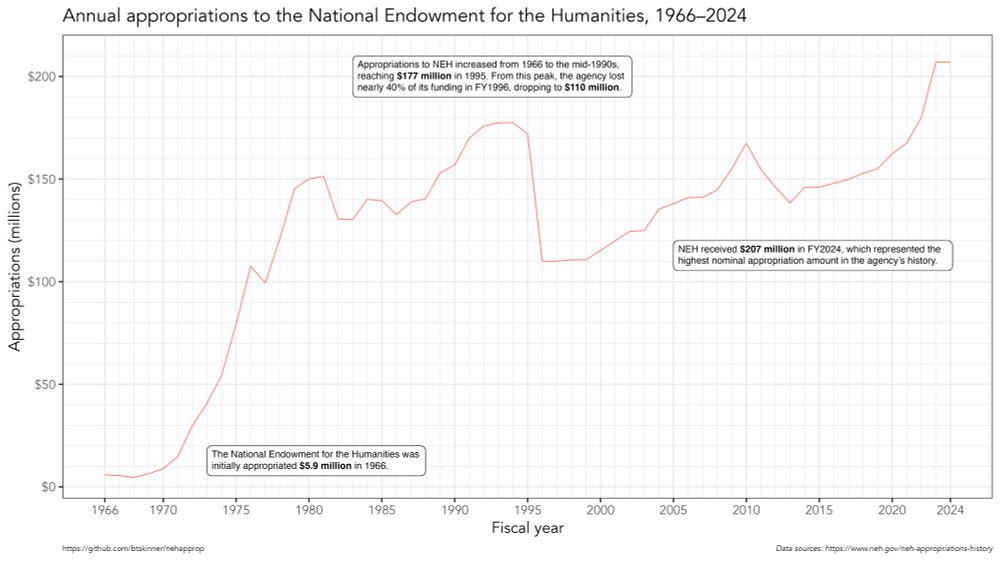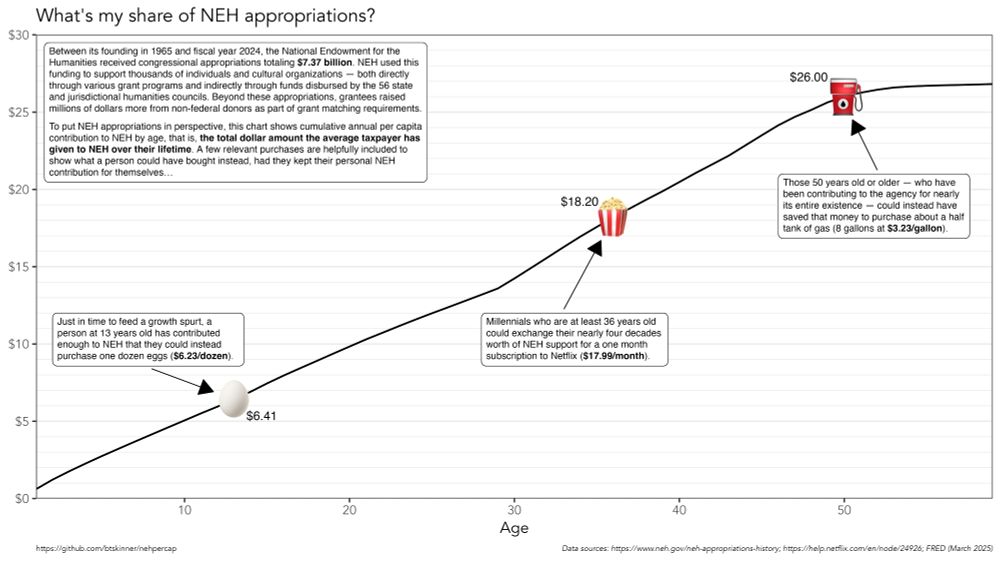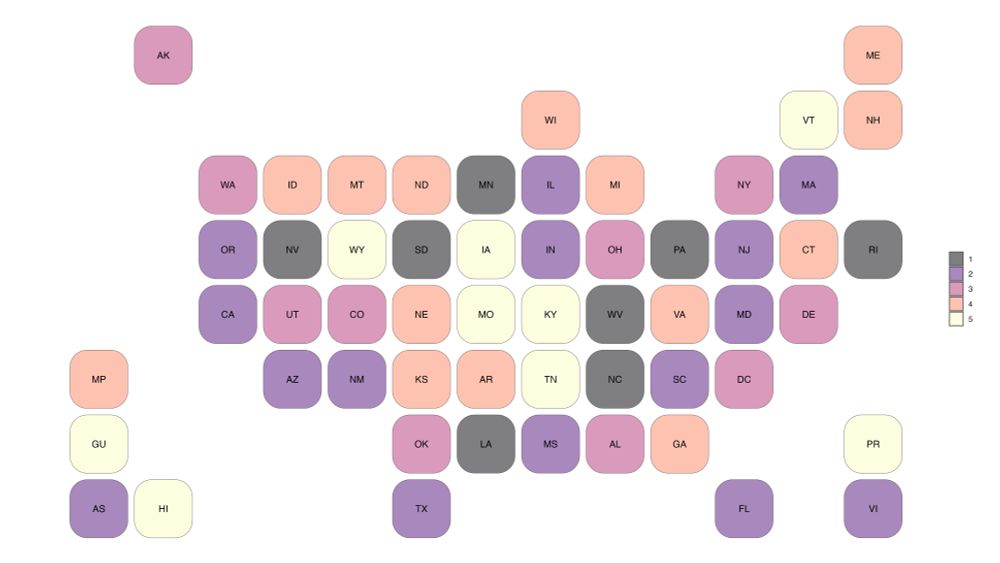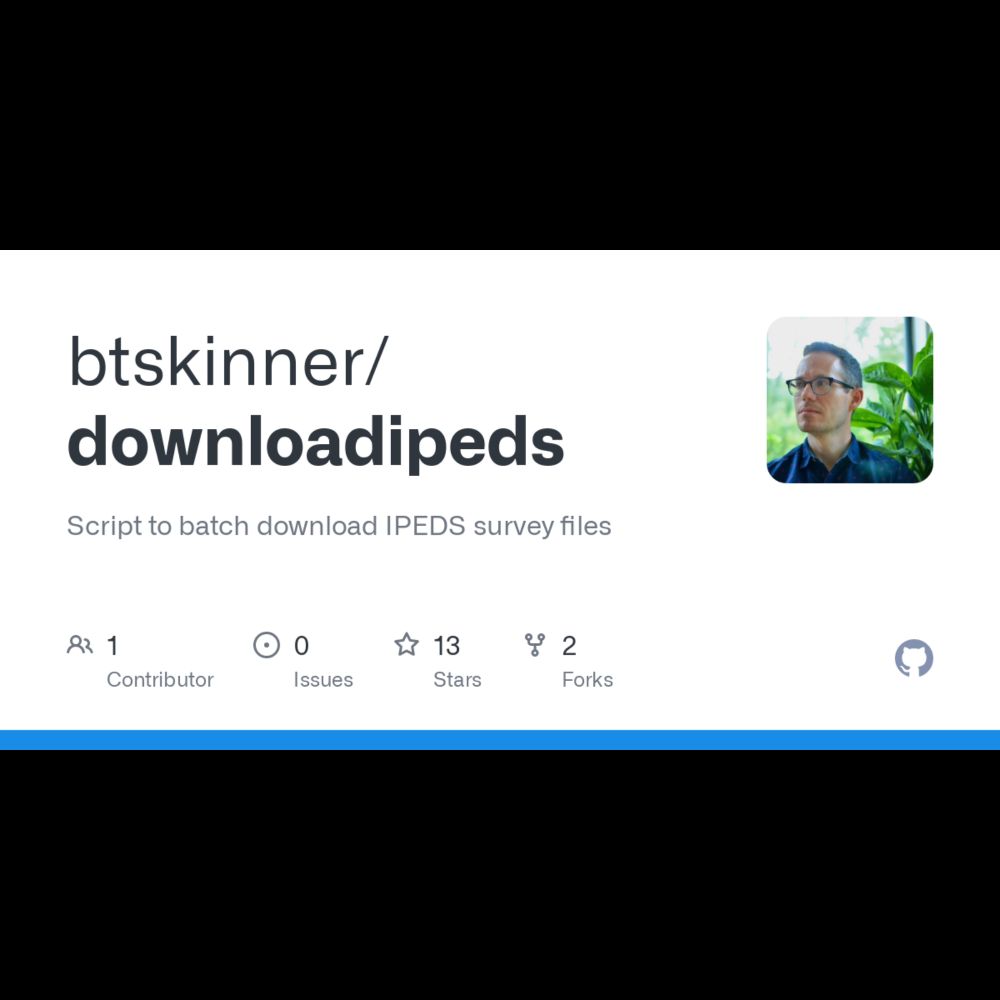And here's a thread of cool things I worked on in my 1.25 years at NEH that I was able to release publicly
11.06.2025 14:22 — 👍 9 🔁 2 💬 1 📌 0ben
@btskinner.io.bsky.social
Data science + noisy music | btskinner.io | he/him
@btskinner.io.bsky.social
Data science + noisy music | btskinner.io | he/him
And here's a thread of cool things I worked on in my 1.25 years at NEH that I was able to release publicly
11.06.2025 14:22 — 👍 9 🔁 2 💬 1 📌 0As a reminder, here's a quick (over) estimate of how much each American has spent over their lifetime to support the work of the NEH
11.06.2025 14:20 — 👍 17 🔁 12 💬 1 📌 0Yesterday was my last day with NEH. All the best to my fellow union members who were also involuntarily separated. All the best to those who were required to stay — keep the 🔥 burning. Join, support, start a union ✊
11.06.2025 14:18 — 👍 26 🔁 3 💬 2 📌 0Increasingly my mental model of corporate LLMs and how they are being used is a less interesting version of I Am Sitting in a Room
14.05.2025 16:47 — 👍 1 🔁 0 💬 1 📌 0Scott is right — my numbers ignore this distribution to make things simpler. By my calculations, most people would get back much more than they actually put in.
Is this trickle down economics? 💁♂️🦋

Line graph titled, "Annual appropriations to the National Endowment for the Humanities, 1966-2024." The x-axis shows fiscal years from 1966 to 2024. The y-axis shows appropriation dollars in millions, from $0 to over $600. There are two lines, one solid showing nominal dollar appropriations to NEH. The other is dashed and shows the inflation-adjusted values, adjusted to real 2024 dollars. The adjusted line is always higher until meeting the nominal line in 2024. It is almost 6 times higher, over $600 million in real dollars, in the 1970s before dropping in the 1980s and 1990s. Two text boxes say: (1) "Adjusted for inflation, annual appropriations to the National Endowment for the Humanities were highest in the late 1970s, reaching over $600 million in 2024 dollars in 1979." (2) "In real terms, NEH appropriations have been relatively flat for the past three decades."
Here are NEH appropriations adjusted for inflation. In real dollars, the agency's highest funding levels were over $600 million (2024 dollars) in the late 1970s and have been flat for the past 30 years. NEH staff have been excellent stewards of public funds, doing so much with increasingly less.
01.05.2025 17:33 — 👍 32 🔁 9 💬 0 📌 1
Line graph titled, "Annual appropriations to the National Endowment for the Humanities, 1966-2024." On the x-axis are fiscal years, which run from 1966 to 2024. On the y-axis are appropriation dollars in millions, from $0 to about $250 million. The charge shows a generally increasing trend that starts about $6 million and ends at $207 million. Three text boxes say: (1) "The National Endowment for the Humanities was initially appropriated $5.9 million in 1966." (2) "Appropriations to NEH increased from 1966 to the mid-1990s, reaching $177 million in 1995. From this peak, the agency lost nearly 40% of its funding in FY1996, dropping to $110 million." (3) "NEH received $207 million in FY2024, which represented the highest nominal appropriation amount in the agency's history."
In FY2024, NEH received $207 million in appropriations — its highest ever. Here's a graph of its funding trajectory over the agency's existence. In talks of efficiency, however, we should account for the real value of those dollars...
01.05.2025 17:33 — 👍 14 🔁 3 💬 1 📌 0Well worth a think: cumulative per capita contributions to #NEH funding vs. the incredible #humanities impact we bring to all 56 states/jurisdictions that we've been posting about here.
NEH staff are responsible stewards of #taxpayer $$, and the benefits for the American public are incalculable.
NEH is funded by the loose change in your sofa.
29.04.2025 17:51 — 👍 9 🔁 1 💬 0 📌 0Not exactly the same, but sort of like this? bsky.app/profile/btsk...
29.04.2025 16:50 — 👍 2 🔁 1 💬 0 📌 0
Line graph titled "What's my share of NEH appropriations" with a caption: "Between its founding in 1965 and fiscal year 2024, the National Endowment for the Humanities received congressional appropriations totaling $7.37 billion. NEH used this funding to support thousands of individuals and cultural organizations - both directly through various grant programs and indirectly through funds disbursed by the 56 state and jurisdictional humanities councils. Beyond these appropriations, grantees raised millions of dollars more from non-federal donors as part of grant matching requirements. To put NEH appropriations in perspective, this chart shows cumulative annual per capita contribution to NEH by age, that is, the total dollar amount the average taxpayer has given to NEH over their lifetime. A few relevant purchases are helpfully included to show what a person could have bought instead, had they kept their personal NEH contribution for themselves..." The x-axis ranges from 0 to 59 years old. The y-axis ranges from $0 to $30. At three ages, items that could have instead been purchased with an individual's lifetime NEH contribution are shown. At 13 years, an egg is plotted on the line with a dollar amount of $6.41 and the caption reads, "Just in time to feed a growth spurt, a person at 13 years old has contributed enough to NEH that they could instead purchase one dozen eggs ($6.23/dozen)." At 36 years, a popcorn bucket is plotted with a dollar amount of $18.20 and the caption reads, "Millennials who are at least 36 years old could exchange their nearly four decades worth of NEH support for a one month subscription to Netflix ($17.99/month)." At 50 years, a gasoline pump is plotted with the dollar amount of $26.00 and the caption reads, "Those 50 years old or older - who have been contributing to the agency for nearly its entire existence - could instead have saved that money to purchase about a half tank of gas (8 gallons at $3.23/gallon)."
As an elder millennial, I could trade my lifetime of tax contributions to the NEH for one month of Netflix and have just enough left over to get some avocado toast if I split it with two other people
29.04.2025 16:13 — 👍 303 🔁 119 💬 1 📌 14In my year at NEH, we did a lot of other data work more directly tied to humanities and agency needs, of course, and were building infrastructure for cool projects in the coming years. These projects represent just small bits in service of that primary work that we thought might also help others.
14.04.2025 16:59 — 👍 7 🔁 0 💬 0 📌 0
A map of congressional districts (2019 at 5m resolution) that includes five inhabited territories served by NEH. Non-contiguous areas are placed around the continental United States in the typical fashion, with western states and territories on the bottom left and Caribbean territories on the bottom right.
Code to convert large US Census state, county, and congressional district shapefiles to lightweight TOPOJSON files for web use. Again, we made this so as to include territories where most solutions do not. Both unprojected and projected files are in the repo. github.com/nehgov/usa_t...
14.04.2025 16:59 — 👍 6 🔁 0 💬 1 📌 0
Choropleth tile map that includes equal area squares for each state plus DC and the five inhabited territories served by NEH. The state / territory squares are arranged to approximate the shape of the United States, with non-contiguous areas placed to the left or right of the main figure. The tiles are color coded with five random shades to demonstrate how it might be used in a data project.
Code to make equal area tile choropleth maps in GeoJSON and TOPOJSON that include territories as well as states. We needed to make these since most existing solutions don't include territories and/or require the use of a specific language (e.g., R). Data files in repo. github.com/nehgov/state...
14.04.2025 16:59 — 👍 6 🔁 0 💬 1 📌 0An R package, ripeds, that allows users to interact with the complete IPEDS data system in an API-like way. Importantly, it allows users to batch download all complete data files and interact with a local directory. More on this in another thread. nehgov.github.io/ripeds/
14.04.2025 16:59 — 👍 8 🔁 1 💬 1 📌 0With most of my NEH colleagues, I was RIF'ed last week. It has been an honor to work with so many talented and dedicated public servants as the agency's first (and for now, last) data scientist. Here's some incidental and public software, code, and data that came about as part of that work:
14.04.2025 16:59 — 👍 25 🔁 7 💬 2 📌 1Currently running to test and it does take a minute, so probably don't wait to last minute if you want the whole thing...
Also remembering I originally wrote this out of anger at the 2013 shutdown. Plus ça change, plus c'est la même chose

Higher Ed friends: if you need IPEDS and fear losing access with a government shutdown, here's a script I wrote that will let you download the entire thing (or select files) github.com/btskinner/do...
24.09.2023 20:15 — 👍 18 🔁 12 💬 1 📌 2